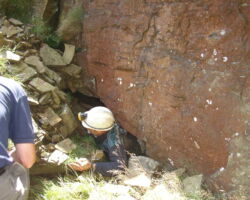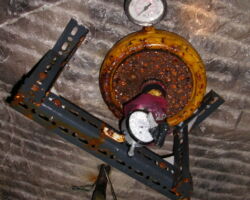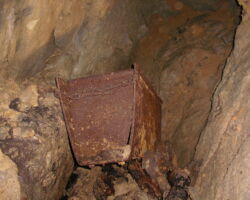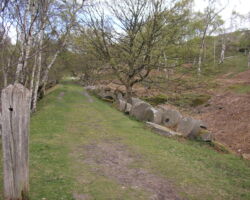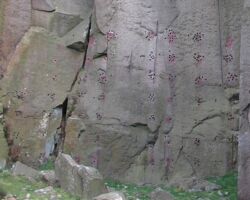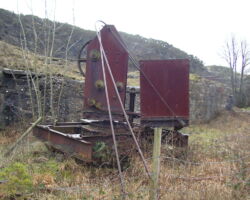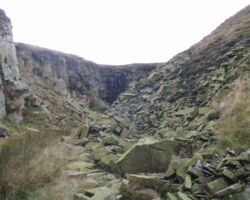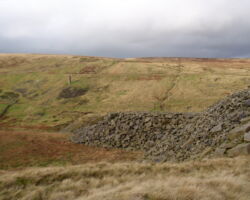Quarries played an important role in the Industrial Revolution they were developed to extract limestone found mainly in the White Peak and sandstone which is largely found in the Dark Peak. The different raw materials have been used for centuries in Derbyshire, their particular characteristics having a strong influence on the appearance of buildings. There are many variants on the limestone and gritstone. Smaller quarries as enterprises extracted other, less significant types of rocks for local and decorative use. These quarries were an important source of building stone, grindstones for mills, paper pulping and the chemical industry. Historic England gives a “Derbyshire and the Peak District Building Stones of England”.
Gritstone quarries
Quarries for building stone and roofing slates are found throughout the area, often in remote moorland locations. Grey slates for roofing were cut at a number of places including Flash, Goytsclough, Macclesfield Common, Pott Shrigley, Wincle, Reeve Edge, Danebower, Blackclough and Rainow. ‘Freestone’ quarried at Danebridge, Forest Chapel and Kerridge was used locally for quoins, gateposts, lintels, sills and flags; further afield it was used for kerb stones and street paving. Huge amounts of stone were used by the railway companies in the construction of bridges, viaducts, station buildings and platforms.
Derbyshire County Council has an interesting list of sources of stone in Derbyshire.
Still widely used today Plug and Feathers were the method to split stone, it is simply a metal wedge (plug) in between two tapering shims (feathers).

Plug and feathers diagram from Wiki
After deciding which direction the grain runs in several holes are cut or drilled 10 to 20cm into the stone to be split. A combined plug and feathers is inserted into the hole with the ‘ears’ of the feathers facing the direction of the intended split. The plugs are then hit in sequence and eventually a crack appears along the line of drilled holes. The technique is still used today with plug and feathers being available from several suppliers. Examples of the use of plug and feathers can be seen at Burbage quarry.
There is also interesting part finished work.
Out of the unusual quarries include –
-
- At Chinley, North of Chinley, due to the nature of the rock strata, flagstones were quarried and unusually for sandstone also mined.
- Middleton mine originally started as a quarry but soon developed into a massive mine with 40km of roadways and was large enough to accommodate heavy machinery and processing plant.
- A cave in the cliff of a quarry at Duffield Bank is believed to be where Rolls Royce hid plans for the Spitfire during the Second World War. There is an engraving on the entrance to the cave which gives the date 1941.
It isn’t practical to list the Hundreds of Derbyshire quarries so just a few unusual examples of quarries are presented.
Cracken Edge at Chinley Churn
Duffield Manor quarry
Matlock – Cuckoostone quarry
Middleton mine
Milltown – Fallgate
Millstone Edge
Minninglow
Reeve Edge
Wirestone
Cracken Edge on Chinley Churn at 451m was a large and long-standing stone slate production site exploited for gritstone in the nineteenth century and probably earlier, finally closing in about 1920.
Cracken Edge has extensive surface gritstone quarries and large scale tips extending for about 1km across open moorland on the Norfolk Estate and quarries appear to have been in their heyday in the period 1800-1850.
Where the Kinderscout Grit has been separated by bands of intervening mudstone into a series of subsidiary leaves, its characteristics change to a more laminated, finer-grained style meaning that it was ideal for stone slate working.
Cracken Edge is a classic example of a particular feature of stone slate quarrying where the tendency was to exploit relatively thin near-surface deposits. The optimum site was the crest of a scarp slope where the dip of the rock was parallel with the land surface. This allowed the quarry to be developed into the dip slope without excessive overburden – sometimes even working two or more galleries – but mainly extending along the crest perpendicular to the dip.
In their pursuit for stone suitable for roof slates, and flooring flags, the quarrymen dug a number of horizontal mines where the overburden became too great.
Entrances to the mainly short workings have become almost blocked and due to the nature of the rock are dangerous.
This is a mine survey for Adit No 8
Considering that Cracken Edge summit is at 451m then a winding engine was installed to send material down the incline.
A private house built in Manor Quarry, Duffield has a cave set within a sandstone face of a quarry. This cave is reputed to have been used in order to provide a secret location for the storage of designed plans for the Rolls Royce Spitfire aircraft. Rolls Royce used a number of secret locations for development and storage of confidential information this site being one of them.
Set deep within the wall of the quarry it is accessed via a metal doorway leading to a weaving passageway 3ft wide by 6.5ft high which ends in a single 10ft square chamber. There’s an engraving on the entrance to the cave which says 1941.
There’s an engraving on the entrance to the cave which says 1941.
According to the owner they had a German au pair and her father came over to collect her and my father showed them the cave.
He told them ‘I was over here in the war trying to find this place to bomb it’.
Matlock – Cuckoostone quarry building ruin.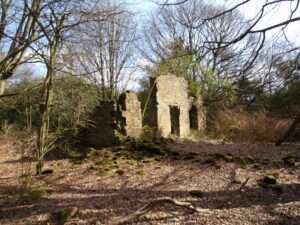
Middleton mine (initially a quarry)
Extraction of limestone started above ground as a quarry around the 1900’s but eventually removing the overburden to access the quality limestone became increasingly difficult. Consequently underground working started here in 1959 and ceased in about 2005 when the mine was effectively mothballed.
Middleton limestone mine is an extensive working running between Middleton-by-Wirksworth and Hopton Wood.
Middleton Mine consisted of 35 kilometres of workings on three levels covering an area of 1400 metres west to east and 800 m north to south and divided into five main production areas by normal faults.
The method of working was by classic room and pillar, with rooms 13 m wide and pillars 17 m square. The extraction height was 8 m. This was an increase from the original pattern of 11 m wide roadways and 14 m square pillars. The Mine developed into the Hopton-Wood Bee Low Limestone bed below a layer of Volcanic Lava which is why most of the Mine is dry as the Lava is impenetrable apart from the natural faults giving some minor leak.
The workings are so massive that the roadways can accommodate heavy machinery and areas cut out to install crushing and grading plant.
Fascinating patterns left by tunnel boring machinery can be seen.
In places the mine intersected old lead workings which still hold artefacts and narrow gauge rails.
Products were used to supply industries as diverse as glass making, sugar refining, mastic asphalt, vinyl floor coverings, bathroom ware, fertilisers, toothpaste and animal feed products.
BAE systems were reported to occupy the deepest levels during the 1980’s and these levels were off limits to all but BAE staff. Their work was classified and kept secret. A leak suggesting that the levels were used for an experimental electronic weapons program has never been proven, but only adds to the mystery. There is also the sugestion that BAE work was above and not below ground – maybe it was both.
Now closed. This is Fallgate quarry at Milltown near Ashover shortly before it closed after a long working life extracting fluorspar and limestone. The fluorspar was unusual in that it fluoresced.
Fluorescence is where ultra-violet light causes fluorite crystals to glow with various colours, usually a milky blue- white. This is common in County Durham fluorite where it is apparently due to traces of rare earths in the fluorite crystal lattice. Durham fluorites contain traces of yttrium, ytterbium and europium, but these are apparently not in sufficient amounts to cause fluorescence in Derbyshire (Dunham, 1952a; Howie et al. 1982). Samples from Watersaw Rake on Longstone Edge and from Fallgate Quarry at Ashover were the only ones to fluoresce according to Bagshaw (1978). Occasionally other Derbyshire fluorites can be seen glowing faintly under strong UV light in a darkened room, though this may be due to organic compounds rather than rare earths. A variety at Castleton showed a narrow red-fluorescing band (Braithwaite et al. 1973).
In the Peak District, however, fluorite is commonly thermo-luminiscent, i.e. crystals and crushed samples glow when heated on a hot plate in a darkened room, as the lattice distortions are re-orientated and energy is released.
Millstone Edge quarry was one of the main sources of Peak District millstones which were made to be used in many industries such as grinding corn, pulping timber for paper manufacture, in paint mills to grind minerals, grindstones for cutlery, pulping apples for cider making, grinding cork for linoleum and grinding mustard seeds.
Dozens of holes can be seen drilled into the rock face, some in groups with dark red paint. Explosive charges were rammed into these holes to quarry the edge. These are the last phases of quarry working that began over 400 years ago.
Quarrying ended at Millstone Edge soon after the last stones were sold to a Swedish paper mill in 1939. The unsold stacks of flat-edged stones lie abandoned and can be seen by the footpath date from this period.
Minniglow – quarry on CHPR
The quarry was developed to provide stone during the construction of the CHPR Cromford and High Peak railway. It is located at the northern end of the embankment below Minniglow so presumably provided the raw material for this. Although this is a large embankment there is an even larger one just a short distance away (Gotham curve).
At the southern end of the embankment is a limekiln which could also have been installed for the same reasons.
A compressed air pumphouse is located at Roystone Grange and this provided power for the rock drills. There is also a powder house used for storing explosives nearby.
Also at the southern end of the embankment is a brick kiln.
Reeve Edge quarry at Danebower
Reeve Edge quarries were developed for the production of stone roofing flags which can be seen on many buildings around the area. An enormous amount of waste was produced during manufacture as can be seen on the surrounding tips.
According to DCC –
“The stone slates from the Reeve Edge quarries …. are extremely hard and strong and apparently difficult to re-hole when this is necessary.”
This old crane post was found at the top of Wirestone quarry which is north east of Matlock. It was hidden in the trees near the trig point’






